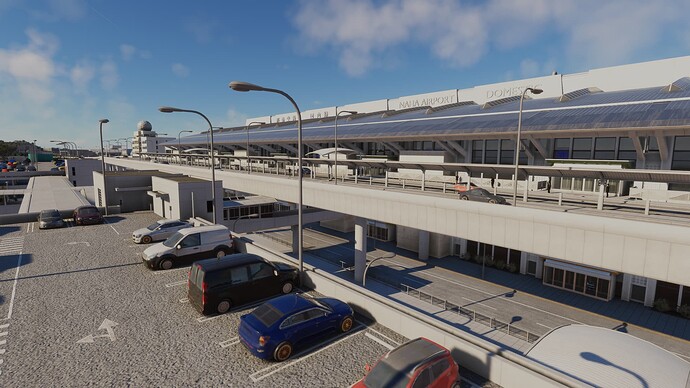Test machine specs: MSI X670E, AMD Ryzen 7 7800X3D, AMD Radeon RX 7900XTX, 48gb RAM
DETAIL
Several previously mediocre developers have this year really started to find their feet, and while I wouldn’t exactly have described MK as “mediocre” this time last year, their recent releases have really impressed.
Okinawa continues where the excellent (if not a little resource-hungry) New York KLGA signed off — in other words, you can expect the same fantastic level of detail, both on and off the airfield. The terminal and its landside are beautifully crafted, featuring high-quality texturing, weathering effects and an abundance of custom assets. There’s an animated MAGLEV train but, sadly, it’s not lit at night and kind of does a floaty trick when it reaches the end of its line (at which point, it returns to the terminal). A very minor annoyance, perhaps, but I have to mention the cons as well as the pros.
The terminal boasts a decent interior, though it’s not on the level of Pyreegue’s EGPH or Drzewiecki’s new EPWA. What is great to see, however, is a complete recreation of the outdoor spectators’ terrace, complete with people and yet more custom assets. Since viewing terraces are a big thing in Japan, it’s pleasing to see this kind of detail fully modelled. It looks incredible.
Out on the apron, everything is in order — good ground texturing and a decent smattering of custom GSE. A recent update added a few military aircraft (JASDF helicopters and P-3 Orions) to the south-eastern ramps. The airfield peripheries get plenty of love, too, with several fully-modelled structures both airside and landside. This airport lies partly on reclaimed land and MK have made a terrific job of adapting and replacing the terrain to make it all fit together. There are, for example, various drainage channels and water breakers across the airfield.
One issue I did notice, upon initial release, was that FSLTL or FST aircraft would only depart RWY36R, while arrivals without exception would use the opposite end of the same runway. Meanwhile, user aircraft would always be given clearance to land on 36L. This obviously created a number of unrealistic conflicts across the airport but the whole issue may have been fixed by the latest update, which claims some AFCAD improvements (I’ve not had chance to fully test).
PERFORMANCE
On my system, performance is very good (certainly better than KLGA!). About on a par with similarly-sized/detailed airports released this year. I’ve noticed some very minor LOD pop but I think that’s what it takes to get highly-detailed airports running nicely in the current sim engine.
VERDICT
This is MK’s first airport outside Europe and North America, and I hope it won’t be the last! For a country that keenly embraces enthusiasm for aviation, Japan in my opinion is very underrepresented in MSFS. But at least I now have somewhere decent to fly to from Drzewiecki’s excellent RJAA… and, presumably pretty soon, Technobrain’s eagerly-awaited RJTT.
If you like flying in East Asia (there are plenty of international routes from ROAH) — or domestically within Japan — this is a very worthwhile airport. There’s even the chance to fly heavies on short, dense routes, since both ANA and JAL use 787s and 777s from Haneda.
It’s arguably the nicest Japanese airport to date, and my only real moan is that there aren’t more airports of this quality in this region. I’d love to see Samscene bring their Fukuoka up to this standard, and for a few other reputable devs to start tackling untouched or outdated airports in Japan. Technobrain’s Kansai and DeVinci’s Kobe are both showing their age a bit now, and the many half-decent freeware projects — with the exception of the recent Ishigaki by Keisim — expectedly aren’t up to payware standards.
I’d also like to see Samscene offer more Japanese city packs, perhaps in volumes like they’ve done with the US and Canada. Naha city looks a bit bland, in spite of MK’s limited efforts to spruce it up a bit. Given the city’s proximity to the airport, it would be great to see the downtown properly modelled.
IMAGES
















